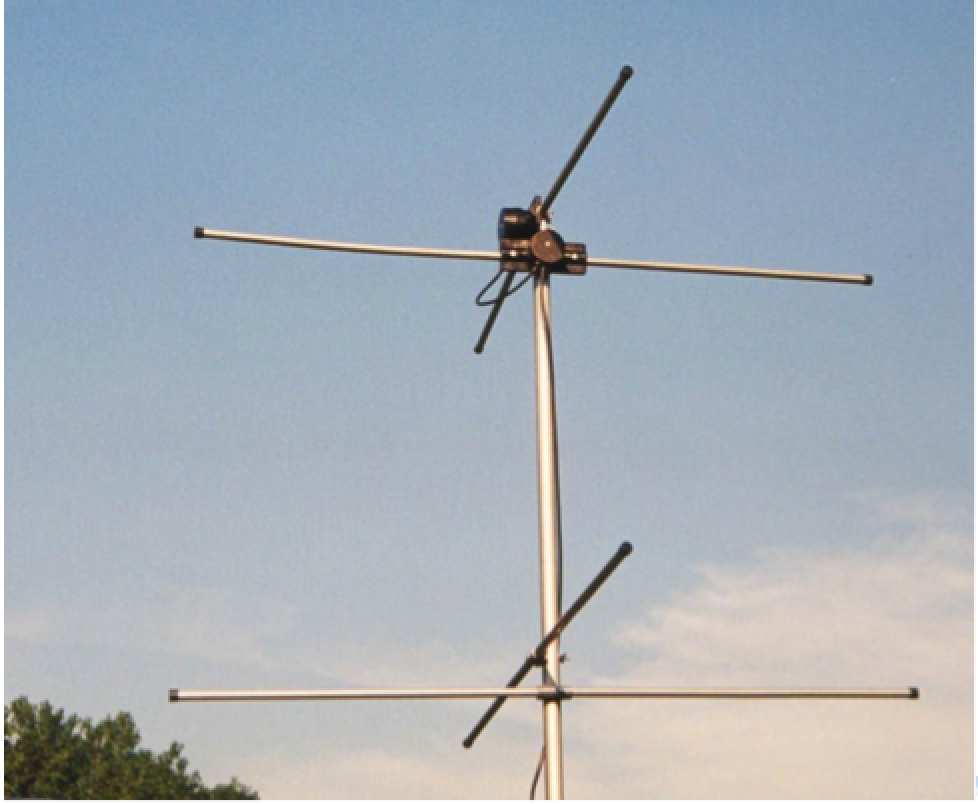Receiving antenna » History » Version 5
« Previous -
Version 5/35
(diff) -
Next » -
Current version
BLANCO GUTIERREZ, Andrea, 03/02/2015 01:07 PM
4. Receiving antenna¶
There are hkhk
4.1. TURNSTILE ANTENNA¶

Figure 3.7: Turnstile antenna [3]
Turnstile antenna, also called Crossed dipoles, was created in 1935 by the American engineer George Brown. Turnstile is an omnidirectional antenna that can be used in horizontal, vertical and circular polarization; the latter polarization is used for satellite communications. [1] The antenna consists of the combination of two pairs of dipoles aligned and positioned at right angles to each other in the same horizontal plane. Each pair of dipoles is called a bay. [2] In addition, a current with the same magnitude and in phase quadrature feeds the antenna.
The phase quadrature can be done by feed-line techniques or by redefining the size of the dipoles. The most common feed-line technique consist in divide the signal using a two-way splitter and after, one of these two divided signals is progressive phase shifted 90°. On the other hand, changing the dimension of the dipoles and adding reactances in serial to them can modify the phase quadrature.
The antenna is built by combining two bays from ½ wavelength to each other and they are excited in phase to modify their radiation pattern. It is illustrated in the picture below.
The vertical radiation pattern is modified because part of it is cancel by the vertical radiation generated by the other bay. It produces a decrease in the vertical radiation energy, but it increases the horizontal one while the vertical angles are also enhance.
The Turnstile antenna radiation pattern is shown in the picture below. The image A shows the omnidirectional radiation pattern of a pair-bay. The image B presents the difference between a circular radiation pattern from a pair-bay and a four-bay.
Finally, the image C illustrates the final radiation pattern of the Turnstile antenna.
There are two modes: Normal mode and axial mode. The normal mode radiates in horizontal polarization due to the position of the orthogonal pairs of dipoles that are in parallel between them and the floor. On the other hand, the axial mode uses circular polarization because the set of dipoles is perpendicular oriented to the receiver signal, in our case, it would be the signal transmitted by the NOAA satellite. Often, this mode is the selected one to satellite communication because by using circular polarization the polarization of the signal does not change with the movement of the satellite in its trajectory. [1]
4.2. QUADRAFILAR HELIX¶
The QFH antenna is considered with a better performance than turnstile. It has composed of two sets of loops, which provides a better performance by reducing noise and eliminating null spots. The two loops have different sizes and they are called large loop and small loop.
4.3. DOUBLE CROSS¶
blabla...
REFERENCES:
[1] http://en.wikipedia.org/wiki/Turnstile_antenna#Satellite_and_Missile.2FRocket_Antenna
[2] http://www.tpub.com/neets/book10/42o.htm
[3]http://www.astrosurf.com/luxorion/qsl-satellites-reception.htm
